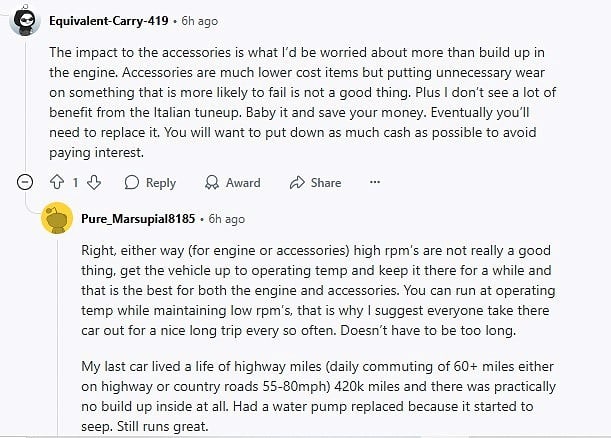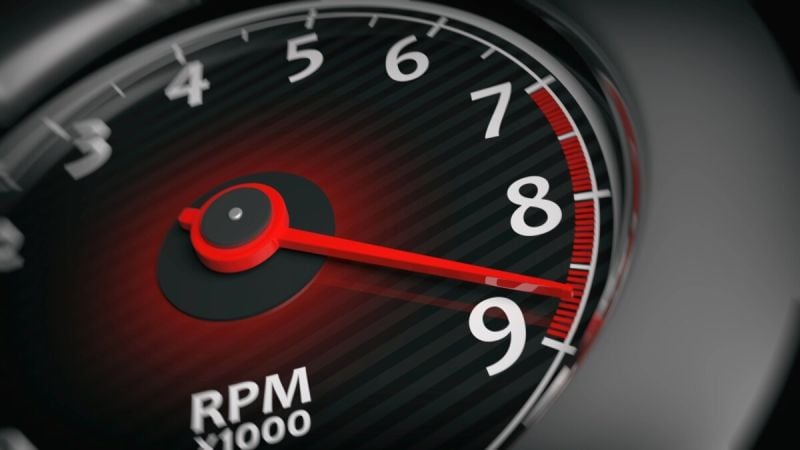A recent Reddit r/MechanicAdvice forum discussion asks whether redlining their old RAV4 is a beneficial or possibly harmful to their family car:
"My family's 2018 RAV4 has always been modestly driven as my dad has been under the impression that rpm is bad for the engine/trans and increases stress and wear. Currently the car has 148k km, oil changes every 10k, and I will be taking it for its first transmission drain and fill at 150k. Mostly city miles, but we'll make an occasional ~400km trip every couple months. I imagine we'll be keeping this car until it completely dies, hopefully at least until 400k-500k km.
Just from reading around I've heard putting your foot to the floor and revving out the engine for a while is beneficial. But this goes against how I was taught to take care of a car. Would it really help or just cause more wear for no reason?"
Is the Italian Tune Up a Myth?
The term "Italian tune-up" refers to the practice of driving a vehicle hard — high RPMs, brisk acceleration, and extended highway speeds — to clear out carbon deposits from the engine and exhaust system. It originated with older carbureted or early fuel-injected European cars that tended to develop carbon buildup from too much low-speed city driving.
Therefore it is not a myth―but is a practice I've observed many car owners misunderstand it and use it as justification for driving the crap out of their sedan too often as if it were a high-performance track car. Especially before an emissions test.
Can a Toyota RAV4 Benefit from an Italian Tune Up?
Because the primary goal of an Italian Tune Up is to burn off carbon deposit buildup within the engine on the valves and pistons and blow it out the exhaust, common sense dictates that today's modern cars like the Toyota RAV4 are not the Dodge Darts of the '70s and therefore are unlikely to need, let alone benefit, from occasional redlining.
In addition, fuel formulations today, with modern, thoroughly designed, and tested additives, have greatly improved the combustion process, leading to significantly reduced carbon deposit buildup.
Still, there are always exceptions to everything, and much of it related to this question depends on how the car is driven. For example, is it driven primarily in town at low speeds and short distances, meaning that the engine temperature remains relatively low in comparison to being driven primarily on the highway for significant periods and faster speeds?
In general, the accepted view is that an "Italian tune-up" might help a RAV4 for:
- Carbon buildup prevention (especially on direct-injection engines): If your RAV4 is driven primarily on short trips, stop-and-go traffic, or low speeds, occasional spirited driving can help burn off light carbon deposits, especially in the exhaust system.
- Restoring throttle response: A long highway drive or a few higher RPM accelerations may make the engine feel a bit more responsive afterward.
However, it offers little benefit and might be harmful:
On modern engines: Newer RAV4s (especially hybrids or those with dual injection) already manage combustion efficiency well. The ECU constantly adjusts fuel-air ratios, and emissions systems are designed to reduce buildup — making Italian tune-ups mostly unnecessary.
If done aggressively or when cold: Revving the engine hard when it's not fully warmed up can cause wear or damage.
Hybrid models: In a RAV4 Hybrid or Prime, the gas engine isn't always on and doesn't rev high often — and forcing it to do so could stress components that weren't designed for that kind of driving.
Several posts in the discussion point to the concern you may be risking doing more harm than helping your RAV4 with redlining:

The Bottom line:
An occasional spirited drive on a fully warmed-up engine may be mildly beneficial for a gas RAV4 that's been babied, but it's not a fix or necessity for most. For hybrid models, it's mostly irrelevant — and unnecessary.
What Automotive Science Has to Say About Italian Tune Ups
In a past Engineering Explained YouTube video addressing the question of whether or not redlining your car is beneficial, the host takes a look into the scientific literature on three factors he believes are relevant to the question:
1. At what temperatures do carbon deposits form?
2. Can carbon deposits be removed with excessive heat?
3. Can engines get hot enough to remove carbon deposits?
The host notes, "An engine's redline is the highest speed it can safely operate. At this engine speed, you'll generally be at higher loads, and the stress and strain on the engine is high. Cylinder temperatures increase with the production of more power, and this heat can have effects on the engine internals. Is it enough to remove carbon deposits?"
According to automotive engineering studies published, the host found that it really depends on the engine type and make being discussed, as well as which components of the engine experience low temperatures with carbon depositing and higher temperatures with carbon "bakeoff" and exhausting.
A summary of the video shows that:
- Between 195 and 290 degrees Celsius, the temperature is optimal for carbon deposits to form on metal components, such as pistons, rings, and valves. If the temperatures are below 195 degrees or above 290 degrees Celsius, then the carbon-on-metal chemistry does not occur.
- Above 325 degrees Celsius, the metal components are too hot for the carbon deposits to remain stuck on as they chemically degrade from the high heat and break apart into smaller compounds that are then "baked off" the metal and exhausted out of the engine.
- The pistons, rings, and valves (intake and exhaust) all operate at nominal temperatures when driving normally. Whether you are getting all components to temps high enough to burn off carbon deposits may not be as simple as an occasional redline drive in the countryside.
"You know the saying ‘a redline a day keeps the carbon at bay’ or things like that, I don't think it's just going to be one redline. I don't think things are necessarily going to get hot enough and that one strong pull in order to start removing deposits won’t do it. I think it's going to take sustained heat more like track driving where you're going to have a lot more heat going into the engine, forcing those temperatures to rise quite a bit.
So, you know, does the theory behind the Italian tune up makes sense? Yes, you can remove deposits with heat. Will it work for every engine? And is it that a simple redline is all you need to do it? I don't quite think so, based on the research that I've found," states the host.
Here's the video for more details and explanation of why an Italian Tune Up may or may not work for your car:
Is Redline Good For Your Car's Engine? Italian Tune Up
Here's a related article for your consideration titled "Car Tune-Up Truths Car Owners Need to Understand Today."
It's Your Turn to Respond About Italian Tune Ups: Do you believe that an Italian Tune Up is justified in today's cars? How about for emission testing? Did you find it made a difference? Tell us about it in the comments section below.
COMING UP NEXT: Dealership Nearly Bricked My Truck ― Brought My 2024 SR5 Tacoma in for the Trailer Blind Spot Monitor Update Recall Last Week
Timothy Boyer is an automotive reporter based in Cincinnati who currently researches and works on restoring older vehicles with engine modifications for improved performance. He also reports on modern cars (including EVs) with a focus on DIY mechanics, buying and using tools, and other related topical automotive repair news. Follow Tim on Twitter at @TimBoyerWrites as well as on Facebook and his automotive blog "Zen and the Art of DIY Car Repair" for useful daily news and topics related to new and used cars and trucks.
Image Source: Deposit Photos












Comments
50 years ago I bought a used…
Permalink
50 years ago I bought a used Volvo that I believe had been driven gently since new. Being young and foolish I drove it fairly hard, reving the engine fairly high. I soon was burning oil and had to rebuild the engine due to broken rings. Someone told me that the reason was probably that the cylinders had a very slight ridge near the top, caused by the wear over the years. When I started driving it harder, I was forcing the piston rods to stretch ever so slightly, but enough to cause the rings to start impacting that ridge. Based on that, doing the Italian tune up on a high mileage engine that’s been gently driven since new might be disastrous.
Good point: There are other…
Permalink
In reply to 50 years ago I bought a used… by Gabe F (not verified)
Good point: There are other reasons why it could have happened, but I think you make a good point alluding to, "If a car has not been redlined in the past, you risk a problem redlining it later in its life." Human health is a good parallel.
Thank you for the share.
Probably not that useful for…
Permalink
Probably not that useful for most. Probably a good excuse to go fast, so helping the engine is just a made up excuse.
Human nature is human nature…
Permalink
In reply to Probably not that useful for… by Jeff (not verified)
Human nature is human nature.
Thanks for the input.
This article is chock full…
Permalink
This article is chock full of speculative technical nonsense. Even the "experts" off reddit got it wrong. You also got it wrong on 75 percent.
???
Permalink
In reply to This article is chock full… by Acura Mechanic (not verified)
???
A redline a day keeps the…
Permalink
A redline a day keeps the mechanic away. No need for excessive "beating" but there is nothing wrong with high rpm acceleration. It is within the designed limitations of the vehicle and is part of normal operation. Direct injection vehicles especially benefit from high rpm. It keeps the back of the valves clean. The oil system is designed to increase pressure as RPM raise, so there really isnt any additional wear unless it is driven hard, at high temps often.
And therein lies the problem…
Permalink
In reply to A redline a day keeps the… by NMK (not verified)
And therein lies the problem: excessive beating is a slippery slope for many car owners who don't know when to stop.
Thanks for the input.
The right reply should have…
Permalink
The right reply should have been, no, your Toyota engine has both direct and port injection and therefore less likely to suffer from carbon buildup. Was this an AI written article?
There will always be some…
Permalink
In reply to The right reply should have… by William Flynn (not verified)
There will always be some carbon buildup, and since the engines are designed to operate at redline for short acceleration periods, it should not hurt to do so with a Toyota. The benefit, however, is likely minimal at best with a Toyota. I would not recommend doing it with an older model that has a likelihood of something else failing during a redline.
People who do not write for a living do not understand AI, but seem to like to throw that around whenever they disagree with someone.
For example, after sending the article to an AI tool I got this response:
"It’s not purely AI-generated. It appears to be a human-authored article that may have used AI as a supporting tool — a growing norm in online writing. That’s different from blindly publishing raw AI output."
Try writing for 30 years or more and then get back to me on that one.
I would worry more about the…
Permalink
I would worry more about the 10K mile oil changes. That long an interval on a gasoline engine especially with an aluminum block shortens engine life substantially. Never go beyond 5K miles if you want your engine to last a long time, even in a Toyota.
Yep, 5K is the way to go…
Permalink
In reply to I would worry more about the… by GeekBoyMN (not verified)
Yep, 5K is the way to go despite what the owner's manual or the service dept. techs say during your free first few oil changes. I buy Toyota oil and filter between those 10K intervals they provide.
Thanks for the reminder.
So buy an EV? Got it. Thanks!
Permalink
So buy an EV? Got it. Thanks!
Is Revving the Engine Silent…
Permalink
Is Revving the Engine Silent Proof of a Cars Happiness?